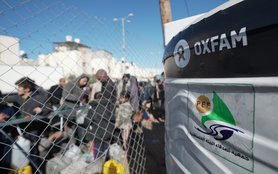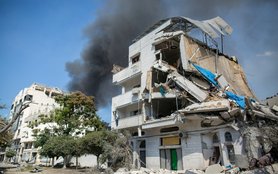NAIROBI—Two point four million Somalis, almost a third of the country’s population, are currently living in crisis due to one of the worst droughts in recent memory, as well as due to the ongoing conflict. According to a coalition of 31 aid agencies, the recent drought has impacted the already volatile food security situation, killing livestock in huge numbers and leading to skyrocketing cereal prices in the country.
Rains expected in Somalia this year have so far been late, and inadequate for communities to recover from the drought’s impact. Although East Africa is prone to recurrent droughts, this year’s recent drought has been unusually severe. Precipitation for this season is forecasted to be below normal. Aid agencies warn that many Somalis risk losing their lives and livelihoods as the impact of the drought intensifies.
Dependent on the rainfall, crop production has been massively affected, as last season’s harvest failed. The next harvest expected in July and August, is likely to be below normal as farmers are dependent on good rainfall for cultivation. With poor households depending on locally produced cheaper cereals, another poor harvest would lead prices to skyrocket further. This would increase the price of survival, making the purchase of food extremely difficult for the vast majority of Somalis that live on less than a dollar a day.
“I have lost everything,” said Mohamed Ali, a pastoralist in Lower Shabelle Region along the coast. Only four months ago, Mohamed was a wealthy pastoralist with 250 cattle. His herd provided nutritious milk for his children, and income for his family. Today, the fields around his home are littered with dead carcasses. He is one of thousands of pastoralists that have lost their livelihoods, and become destitute. Recently, he slaughtered his last cow to sell its hide for 2 dollars. This is his last opportunity to raise income to feed his children.
One in four children are now suffering from acute malnutrition in the southern parts of Somalia which is the worst affected. In some areas, malnutrition is affecting 30 percent of the population. This is one of the highest rates of malnutrition in the world, and double the threshold of an emergency. There are now 241,000 children acutely malnourished across Somalia, of whom 57,000 are severely malnourished.
The price of food continues to soar, and this trend is likely to continue for the coming months. In Bay region, cereal prices have soared by 135 per cent since the same time last year. People are struggling to buy basic supplies as prices skyrocket. For the poorest in Somalia, the worst affected by this drought, the situation is becoming unsustainable.
Over 55,000 people have been displaced by the recent drought and many others are migrating to urban areas in search of food and water. For farmers and pastoralists, it will take many seasons for their livelihoods to recover from the devastating impact of the drought.
With a major funding shortfall, aid agencies have insufficient resources to address the needs of those affected. While access remains a challenge, many agencies are still managing to provide life saving assistance to those in need.
We are urging the international community to increase and diversify humanitarian funding to save lives, and to provide longer term funding for development, and to rebuild livelihoods lost to the drought.
The signatory agencies include:
Agency for Technical Co‐operation and Development (ACTED)
International Rescue Committee (IRC)
Adventist Development and Relief Agency - ADRA Somalia
Juba Foundation
African Rescue Committee (AFREC)
Kaalo
Baniadam Relief & Development Organization
Kisima Peace and Development Organisation
BTSC
MEDAIR
CARE
Mercy Corps
CESVI
Norwegian Church Aid (NCA)
Concern Worldwide
Oxfam
COOPI
Social‐life and Agricultural Development Organization(SADO)
Danish Refugee Council (DRC)
Save the Children Somalia/Somaliland
HAVOYOCO Somali Family Services (SFS)
HIJRA
SOCED
Horn Relief
Trócaire
Integrated Development Focus (IDF)
Vétérinaires Sans Frontières– Germany (VSF Germany)
International Solidarity Foundation (ISF)
World Vision
Intersos
Data from the Food, Security and Nutrition Analysis Unit (FSNAU/FAO Somalia) has been used in this statement. More information can be found on their website www.fsnau.org


